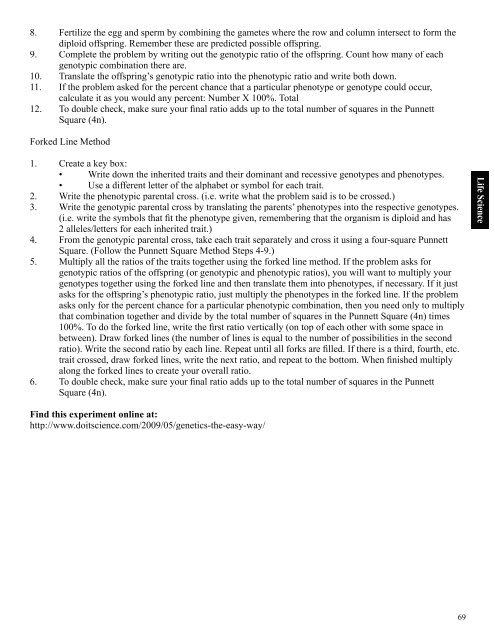ScienceMakers Toolkit Manual - The History Makers
ScienceMakers Toolkit Manual - The History Makers
ScienceMakers Toolkit Manual - The History Makers
You also want an ePaper? Increase the reach of your titles
YUMPU automatically turns print PDFs into web optimized ePapers that Google loves.
8. Fertilize the egg and sperm by combining the gametes where the row and column intersect to form the<br />
diploid offspring. Remember these are predicted possible offspring.<br />
9. Complete the problem by writing out the genotypic ratio of the offspring. Count how many of each<br />
genotypic combination there are.<br />
10. Translate the offspring’s genotypic ratio into the phenotypic ratio and write both down.<br />
11. If the problem asked for the percent chance that a particular phenotype or genotype could occur,<br />
calculate it as you would any percent: Number X 100%. Total<br />
12. To double check, make sure your fi nal ratio adds up to the total number of squares in the Punnett<br />
Square (4n).<br />
Forked Line Method<br />
1. Create a key box:<br />
• Write down the inherited traits and their dominant and recessive genotypes and phenotypes.<br />
• Use a different letter of the alphabet or symbol for each trait.<br />
2. Write the phenotypic parental cross. (i.e. write what the problem said is to be crossed.)<br />
3. Write the genotypic parental cross by translating the parents’ phenotypes into the respective genotypes.<br />
(i.e. write the symbols that fi t the phenotype given, remembering that the organism is diploid and has<br />
2 alleles/letters for each inherited trait.)<br />
4. From the genotypic parental cross, take each trait separately and cross it using a four-square Punnett<br />
Square. (Follow the Punnett Square Method Steps 4-9.)<br />
5. Multiply all the ratios of the traits together using the forked line method. If the problem asks for<br />
genotypic ratios of the offspring (or genotypic and phenotypic ratios), you will want to multiply your<br />
genotypes together using the forked line and then translate them into phenotypes, if necessary. If it just<br />
asks for the offspring’s phenotypic ratio, just multiply the phenotypes in the forked line. If the problem<br />
asks only for the percent chance for a particular phenotypic combination, then you need only to multiply<br />
that combination together and divide by the total number of squares in the Punnett Square (4n) times<br />
100%. To do the forked line, write the fi rst ratio vertically (on top of each other with some space in<br />
between). Draw forked lines (the number of lines is equal to the number of possibilities in the second<br />
ratio). Write the second ratio by each line. Repeat until all forks are fi lled. If there is a third, fourth, etc.<br />
trait crossed, draw forked lines, write the next ratio, and repeat to the bottom. When fi nished multiply<br />
along the forked lines to create your overall ratio.<br />
6. To double check, make sure your fi nal ratio adds up to the total number of squares in the Punnett<br />
Square (4n).<br />
Find this experiment online at:<br />
http://www.doitscience.com/2009/05/genetics-the-easy-way/<br />
69<br />
Life Science










